Tricky orienteering with lots of mistakes from the top ranked runners led to a very interesting middle distance World Cup race in Idre Fjäll this rainy Saturday. We got surprise victories in both the women’s and men’s race – with junior Hanna Lundberg (Sweden) winning the women’s race from start number one and Joey Hadorn (Switzerland) winning the men’s race.
In the women’s class Lundberg’s victory margin was 1:02 down to Natalia Gemperle (Switzerland) with Natalia Gemperle (Russia) another 14 seconds behind. In the men’s class Hadorn’s victory margin was only 3 seconds down to teammate Daniel Hubmann, with Simon Hector (Sweden) in third 36 seconds behind.
The variation between high-speed open terrain and terrain with denser forest (and quite hidden controls) which required very careful orienteering made proved to be very challenging for the athletes. As you can see from the map above (men’s course – the women had a similar course setup as shown below), the first part of the course was in a tricky slope featuring mostly uphill running, the second part was in an open area which invited the runners to speed up, and the last part was in a tricky slope with very few details featuring mostly downhill running.
We probably haven’t seen a race with that many mistakes from top runners and so many changes in the top since the epic WOC relay in France back in 2011. A real drama – definitely worth watching if you haven’t watched it yet, even if you know the results.
Women: Waiting game for Lundberg
In the women’s race Lundberg had to start the race with start number one as she does not have ranking points enough to be seeded – but this will likely be the last time that happens after the 19-year old took her first World Cup victory today. Thus Lundberg finished her race a long time before the TV broadcast from the women’s race started, but in the end she got more TV-time than all of the other runners anyway as the producer showed the smiling Swede in the leader chair at regular intervals as one after another of the top ranked runners did mistakes.
The below splitsbrowser shows the race development for the top 7 runners – plus Sara Hagström who had a good start of the race but finished down in 15th. The comparison is made against “superman” (or actually superwoman), that is the sum of the best split times for each leg. As you can see from the illustration, Lundberg did have a very fast start and had the leading position at the first control, but several runners were faster than her to the next controls, partly because Lundberg kept the speed down to focus on safe orienteering. The fastest to the next controls was Tove Alexandersson (Sweden) who kept the lead until control 4 – but a small mistake to control 5 made Thursday’s winner from the long distance, Simona Aebersold (Switzerland), take over the lead. Later big mistakes to control 15 and 16 put Alexandersson down to 5th place.
Aebersold looked a lot like the winner for most of the race, but nearly two minutes lead to Lundberg at control 15 was not enough for the Swiss – who will dream about the 2:30 mistake at the 16th control tonight. Still, it was enough for the seconds place. Natalia Gemperle (Russia) came straight from a 15(!) minute mistake on thursday’s long distance, and didn’t look like a runner battling for the Top-3 in the first part of the race. However, with many runners doing mistakes towards the end, Gemperle suddenly came out of the forest and snatched the 3rd place from the Swedes (see the blue line which is close to flat – indicating “superwoman” speed – in the last part). The secret behind Hanna Lundberg’s victory: Consistency – Lundberg lost 40 seconds or less to the leg winner on all legs – that was least of all runners in this race.
Karolin Ohlsson looked like a podium runner for a while – only a few seconds behind Lundberg at control 15 – and beating Tove Alexandersson with a few seconds after a strong run-in. The mistake to control 16 was too big, however – especially compared with Gemperle’s very strong run on this leg.
Sara Hagström (Sweden) also had a very good start, but a big mistake to control 5 (and later also big mistakes to control 15 and 17) took Hagström out of the medal contention. Another runner with a good start was Lisa Risby (Sweden), who was close to Lundberg and far ahead of 3rd place finisher Gemperle until control 14 – but a big mistake to control 14 and slower speed after the mistake kept Risby out of the podium.
The below splits browser illustration includes all top 10 runners plus Hagström, to show that there were even more runners who could have mixed in higher up in the results with good technical races.
Below some selected legs from the GPS-tracking are included:
Men: Swiss surprise
In the men’s race there were even more changes in the top than in the women’s race, as the below splits browser illustration shows. As in the women’s race, we had a Swedish early-starter – Simon Hector – who sat in the leader’s chair from the start of the day and finished on the podium in the end. Hector is yet another Covid-victim after WOC in Czech Republic, and as his physical shape was not 100%, his focus was on secure orienteering rather than speed – a focus which brought Hector all the way to the third place in the end.
Runner after runner tried to beat Hector’s time, and failed. At the first TV-control (control 4) Hector was down in 29th(!) place at +1:19, but runner after runner did big mistakes on the tricky parts of the course, and finished behind Hector.
The runner who had the highest speed to the first TV-control was Kasper Fosser (Norway), who again looked like a clear winner halfways through the race – and even had winner chances towards the last part of the course – but all the mistakes cost Fosser far too much time, and in the end the Norwegian finished in 6th place. Another runner who looked strong at the first TV-control was Gustav Bergman (Sweden). Bergman was only 15 seconds behind Fosser in second place at the first TV-control, but a 3 minute mistake at control 8 took the spirit out of Bergman, who lost even more time afterwards and finished in 18th place. Another runner who looked like a possible winner for a (short) time was Finnish Joonas Ahola – with a surprisingly strong performance. With a quite early start he had a clear lead over Hector at the second TV-control (control 13) – and when all runners had passed the Finn still had the second best time here. A big mistake to control 14 did however cost too much time, though, but a 4th place is still an excellent results.
Albin Ridefelt (Sweden) was also on the track for victory – with a clear lead to Hector as late as control 15 (with only a few seconds up the the later starting winner Joey Hadorn) – but the 16th control cost the Swede nearly 1:30 with the 79th best split time, and thus he fell down to the 5th place.
Joey Hadorn did not look like a winner in the early parts of the race, running a race similar to Hector’s early in the first part of the race, nearly 2 minutes behind Kasper Fosser in 16th place at control 7. But when most of the other runners did mistakes, Hadorn managed to keep his orienteering together, and climbed steadily on the results as other runners did mistake after mistake.
Another runner who did an excellent race was Daniel Hubmann (Switzerland). Hubmann was the only runner who never was more than one minute behind the leader – and in the end he finished in second place only 3 seconds behind Hadorn after doing several smaller mistakes towards the end of the race. An interesting side story in this race is that Daniel Hubmann was extremely disappointed after losing a medal to Magne Dæhli and Matthias Kyburz running in a pack with Kasper Fosser at WOC Long distance. Today Hubmann caught both Matthias Kyburz (4 minutes, Switzerland) and Magne Dæhli (2 minutes, Norway) and they ran in a pack most of the race, seemingly with Kyburz in front and Hubmann in the back seat based on the split times. Kyburz then managed to run away from Hubmann – Hubmann would have taken a clear win if he would have kept together with Kyburz until the end (see illustration below). Also on Thursday’s long distance Hubmann took a podium place after running in a pack with Gustav Bergman in large parts of the race.
Matthias Kyburz, reigning WOC Middle distance champion, did definitely have the strongest finish of the day. After his nearly 5 minutes of mistakes early in the course (+4:40, 105th place at control 3, still +4:58, 69th place at control 6), he ran an excellent race and finished in 9th place, only 1:54 behind Hadorn.
Several other runners also looked like possible winners out there – starting strongly and missing towards the end. The below splits browser includes some additional would-be-winners. Both Emil Svensk and Max Peter Bejmer were well ahead of the rest of the field at control 10, but very big mistakes to control 11 and 15 destroyed all chances for a top result for both Swedes. Eskil Kinneberg (Norway) was also in the battle for top results for a while, but did mistakes towards the end.
Mistakes, mistakes, mistakes – what a race! #GPSanimation of the men's tricky & dramatic World Cup Middle distance in Idre is worth a watch. Hadorn 🇨🇭,Hubmann🇨🇭 and Hector 🇸🇪 do least mistakes – others like Fosser🇳🇴 & Bergman 🇸🇪 are in lots of trouble… pic.twitter.com/kEU9R0nY0m
— WorldofO.com (@worldofo) August 15, 2021
Below some selected legs from the GPS-tracking are included:
Maps and GPS-tracking
The map for the men’s course is available at the top of the page (direct link here), and the women’s man below (direct link here). GPS-tracking is available from the GPS-provider TracTrac.
Results
Men
| 1 | Joey Hadorn | 40:00 | 6:15 | |||
| 2 | Daniel Hubmann | 40:03 | +0:03 | 6:16 | ||
| 3 | Simon Hector | 40:36 | +0:36 | 6:21 | ||
| 4 | Joonas Ahola | 40:42 | +0:42 | 6:22 | ||
| 5 | Albin Ridefelt | 41:18 | +1:18 | 6:27 | ||
| 6 | Kasper Harlem Fosser | 41:30 | +1:30 | 6:29 | ||
| 7 | Isac von Krusenstierna | 41:44 | +1:44 | 6:31 | ||
| 8 | Soren Thrane Odum | 41:48 | +1:48 | 6:32 | ||
| 9 | Matthias Kyburz | 41:54 | +1:54 | 6:33 | ||
| 10 | Topi Syrjalainen | 41:55 | +1:55 | 6:33 | ||
| 11 | Eskil Kinneberg | 42:03 | +2:03 | 6:34 | ||
| 12 | Lukas Liland | 42:06 | +2:06 | 6:35 | ||
| 12 | Max Peter Bejmer | 42:06 | +2:06 | 6:35 | ||
| 14 | Severi Kymalainen | 42:14 | +2:14 | 6:36 | ||
| 15 | Simon Imark | 42:18 | +2:18 | 6:37 | ||
| 16 | Christoph Meier | 42:43 | +2:43 | 6:41 | ||
| 17 | Audun Heimdal | 42:46 | +2:46 | 6:41 | ||
| 18 | Gustav Bergman | 42:53 | +2:53 | 6:42 | ||
| 19 | Rassmus Andersson | 42:59 | +2:59 | 6:43 | ||
| 20 | Olli Ojanaho | 43:05 | +3:05 | 6:44 |
Women
| 1 | Hanna Lundberg | 39:20 | 7:13 | |||
| 2 | Simona Aebersold | 40:22 | +1:02 | 7:24 | ||
| 3 | Natalia Gemperle | 40:36 | +1:16 | 7:26 | ||
| 4 | Karolin Ohlsson | 41:40 | +2:20 | 7:38 | ||
| 5 | Tove Alexandersson | 41:42 | +2:22 | 7:39 | ||
| 6 | Lisa Risby | 42:12 | +2:52 | 7:44 | ||
| 7 | Svetlana Mironova | 42:48 | +3:28 | 7:51 | ||
| 8 | Johanna Oberg | 43:13 | +3:53 | 7:55 | ||
| 9 | Marion Aebi | 43:47 | +4:27 | 8:02 | ||
| 10 | Andrea Svensson | 44:27 | +5:07 | 8:09 | ||
| 10 | Sabine Hauswirth | 44:27 | +5:07 | 8:09 | ||
| 12 | Marie Olaussen | 44:46 | +5:26 | 8:12 | ||
| 13 | Elena Roos | 44:50 | +5:30 | 8:13 | ||
| 14 | Jana Knapova | 45:14 | +5:54 | 8:17 | ||
| 15 | Sara Hagstrom | 45:35 | +6:15 | 8:21 | ||
| 16 | Adela Indrakova | 45:37 | +6:17 | 8:22 | ||
| 17 | Veronika Kalinina | 46:15 | +6:55 | 8:29 | ||
| 18 | Lotta Karhola | 46:20 | +7:00 | 8:30 | ||
| 19 | Paula Gross | 46:28 | +7:08 | 8:31 | ||
| 20 | Ingeborg Eide | 47:11 | +7:51 | 8:39 |
 World of O News
World of O News
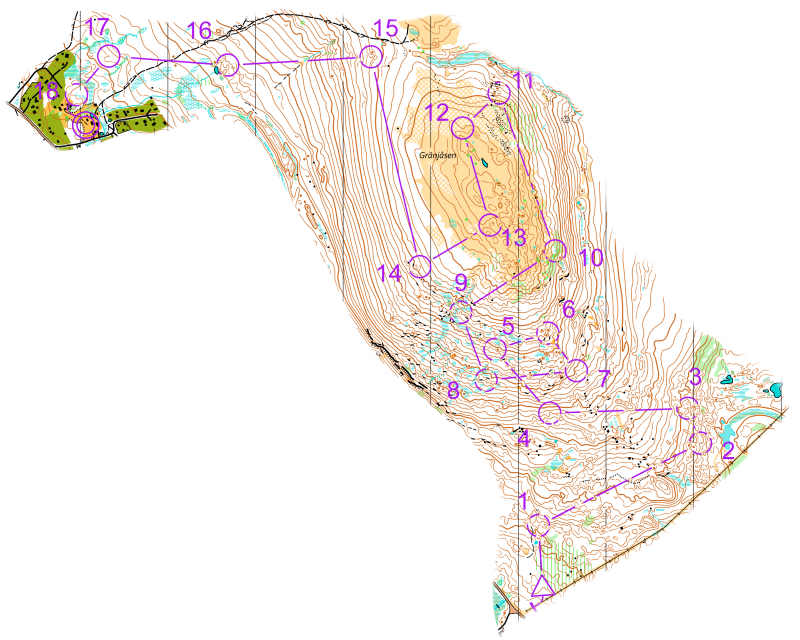

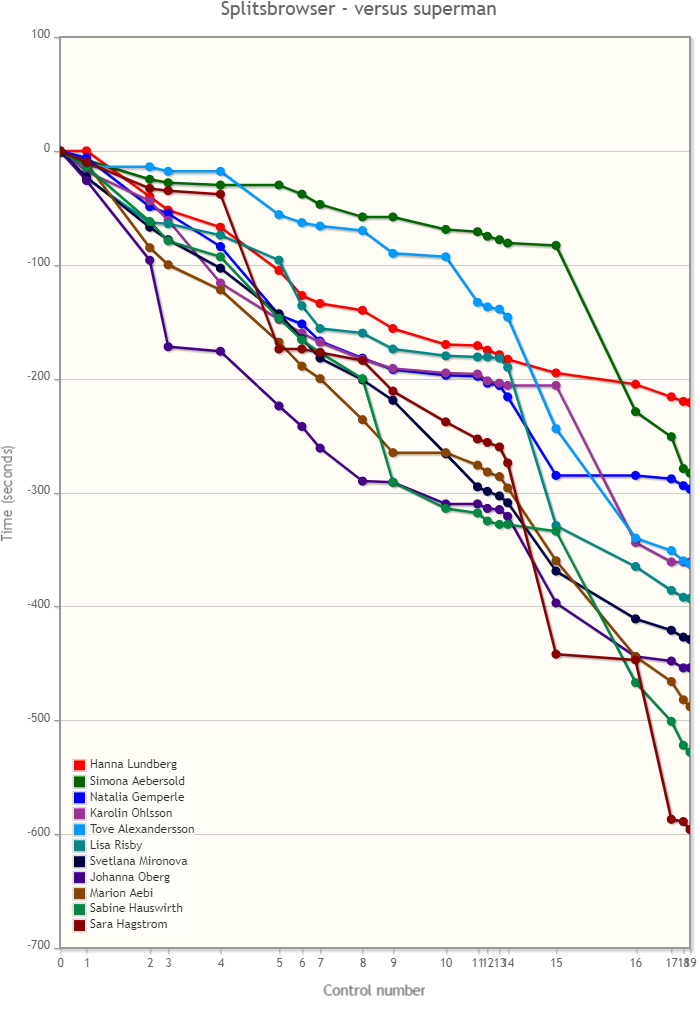
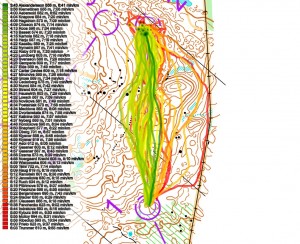
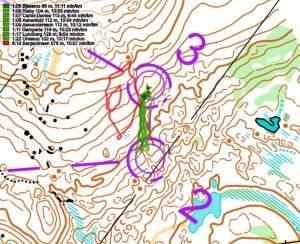

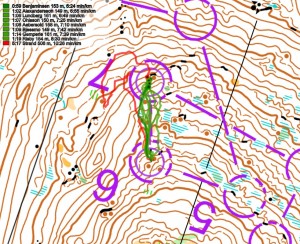
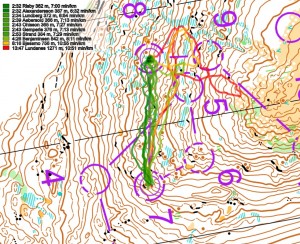
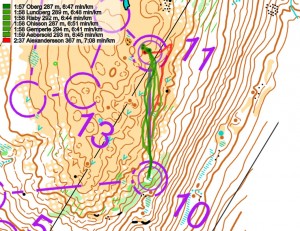

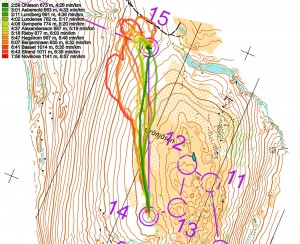
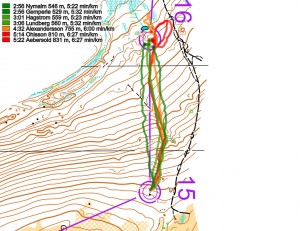
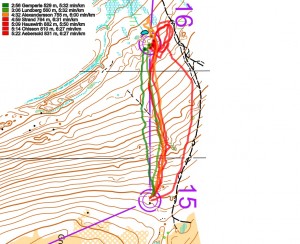
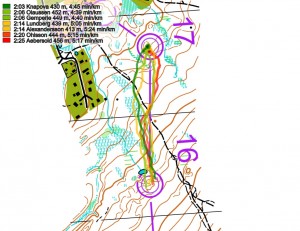
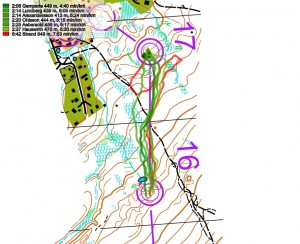
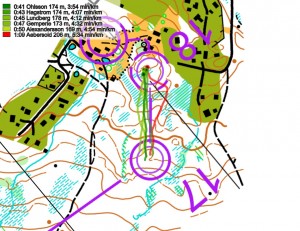
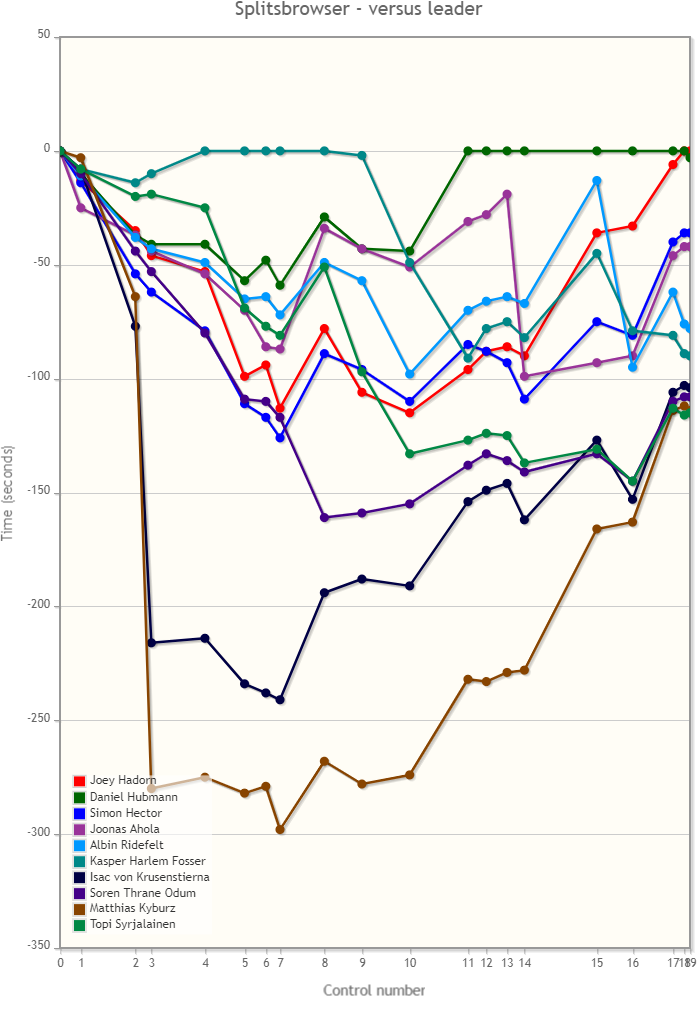
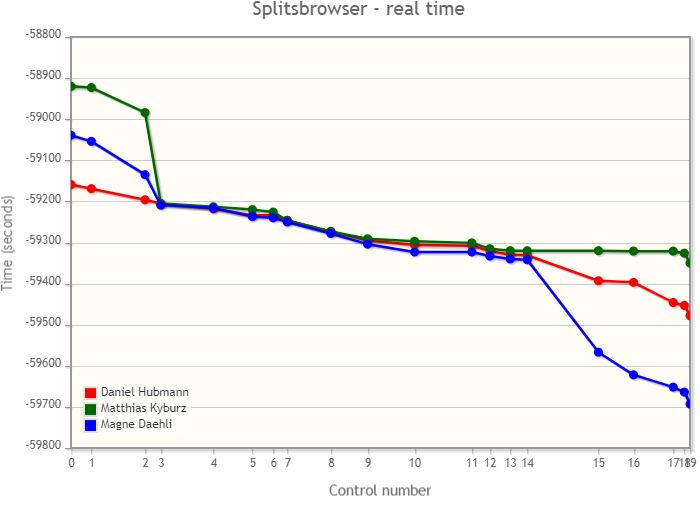
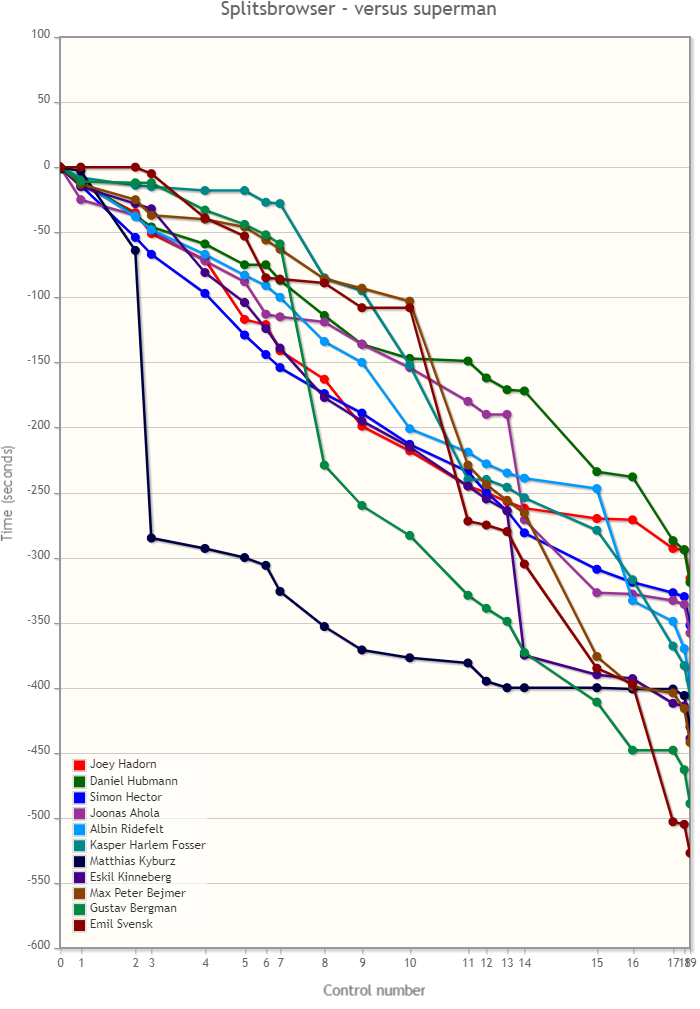
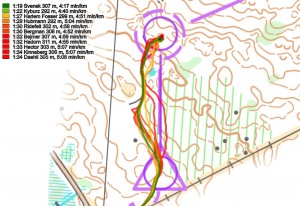
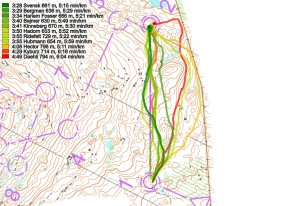
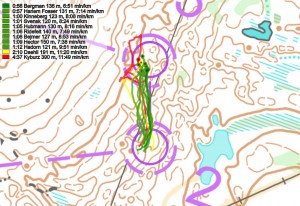
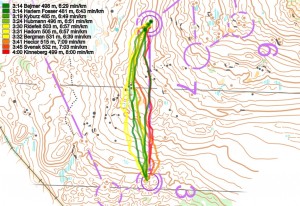
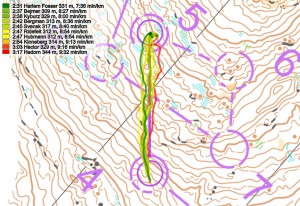
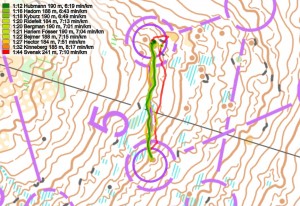

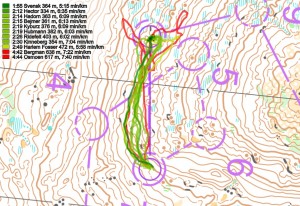
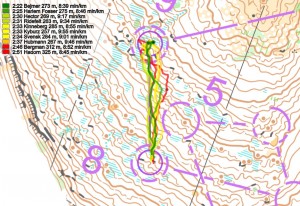
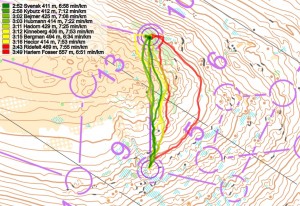
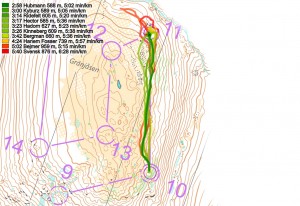
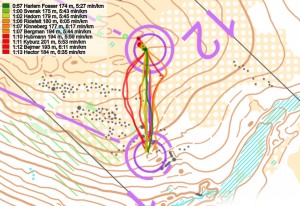
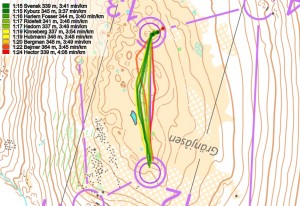
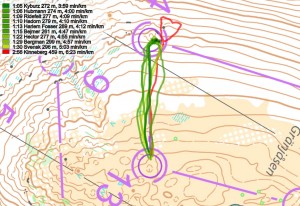
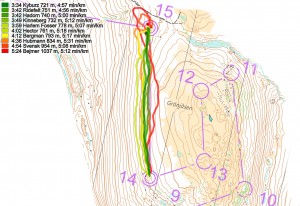
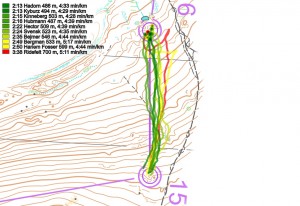
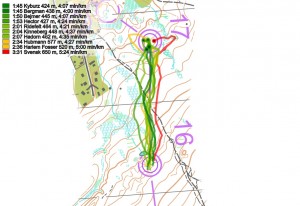
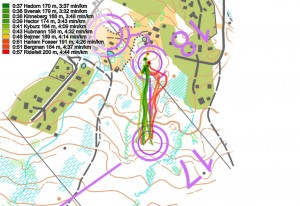
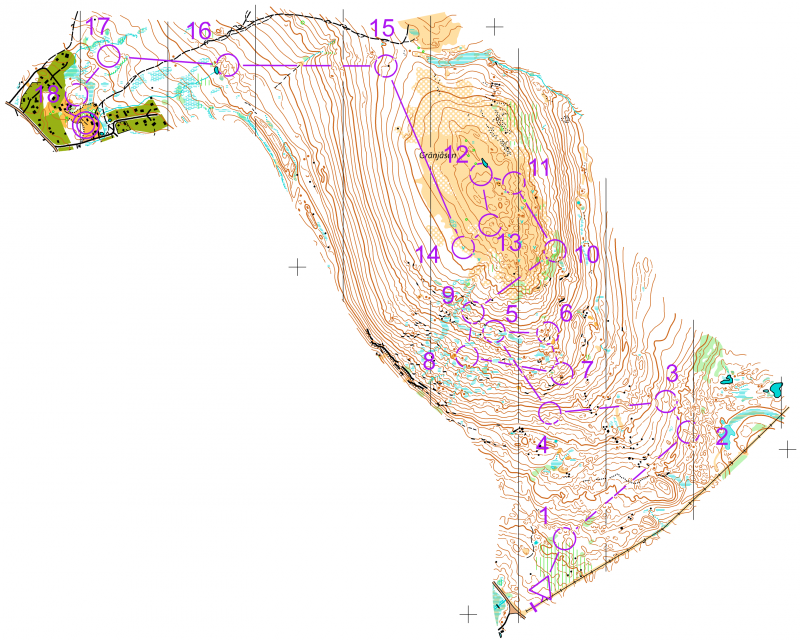




Good morning.
Way up on top you wrote Simona Gemperle instead of Simona Aebersold
Surprised to see so many top runners take such risky route choices in this terrain.
Please include Lukas Liland in your analysis! He was in front of Hector until very near the end, right?
For such a young runner (on the JWOC teams with Kasper several years in a row), the long and middle here was a near-breakthrough weekend omho.
Of course this was exciting to see… but there were simply to many mistakes in this middle (and the relay in the same terrain). Joey from 10th to 1st and Simon from 19th to 3rd in the last part of the course indicate that at least this part was almost impossible to tackle properly.
One might say that Lundberg, Hadorn and Hector were the ones doing it right, but they also might just have been the lucky ones…
In the end it is up to the competitors to advocate the game they want be part of. If they see luck and pack as part of the game it so will be.
Hadorn ran the deciding part in company with Kinneberg and Kral. (src: tractrac)
Hubmann is a very strange person, he cried during the WOC because some runners ran together, he did exactly the same thing…
Just a jealous Guy….
He owned up to following Bergman on twitter: https://twitter.com/dhubmann?lang=en
And he didn’t “cry” – he just pointed out how this unfairness happens every year.
https://www.instagram.com/p/CRIuZxXMFId/
I thought Hubmann was one of the few athletes with the stature to make this point without people personalizing it against him. Sadly not – sometimes you win, sometimes you lose, but either way the unfairness continues.
Though I really dislike pack-running, I do not agree with you, V.
At WOC Kyburz and Daehli ran with Fosser together from the moment Fosser caught up with them, and splits show they ran remarkably better and faster than before Fosser caught up with them. You can clearly see the ‘before-Fosser’ and ‘after-Fosser’ in their splits, and the difference is undeniable.
As for Hubmann at the WC, you can see he caught up with Kyburz and Daehli, and after that his performance stayed the same as before catching up with them. He didn’t suddenly increase speed or accuracy, there is no distinctive ‘before’ or ‘after’ in his splits (though there is, again, for Daehli).
Also the day before, when Bergman caught up with him, you can clearly see he ran his own race. As soon as Bergman made the smallest mistake, Hubmann was off and kept running a good and steady race. This clearly shows Hubmann didn’t just follow or let himself get distracted.
Maybe (or probably) he profited from the other runners, just as other runners probably profited from him. But in my opinion Hubmann did run his own race throughout the competition.
What about the JWOC sprint analysis, the courses seems intersting.